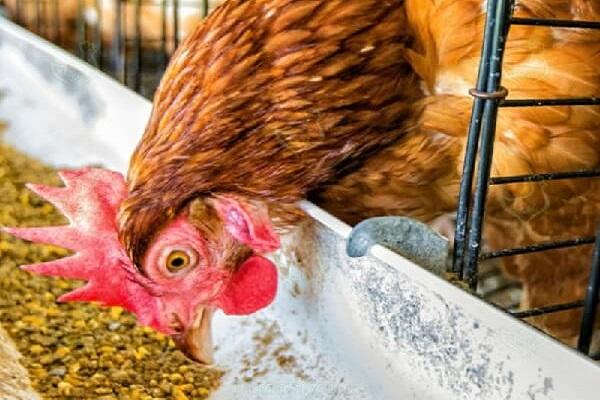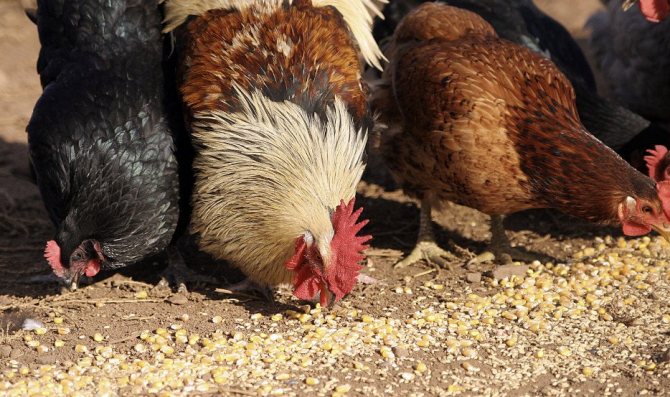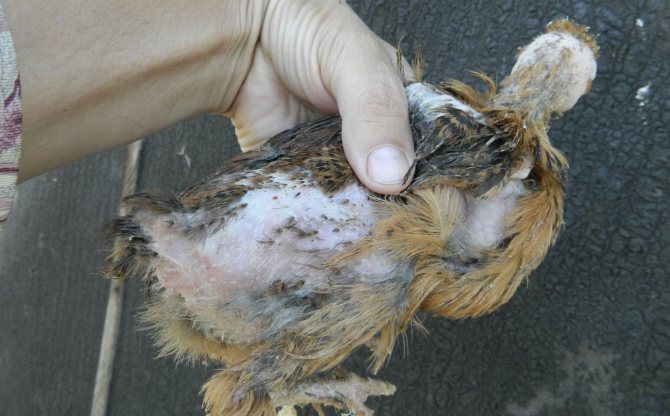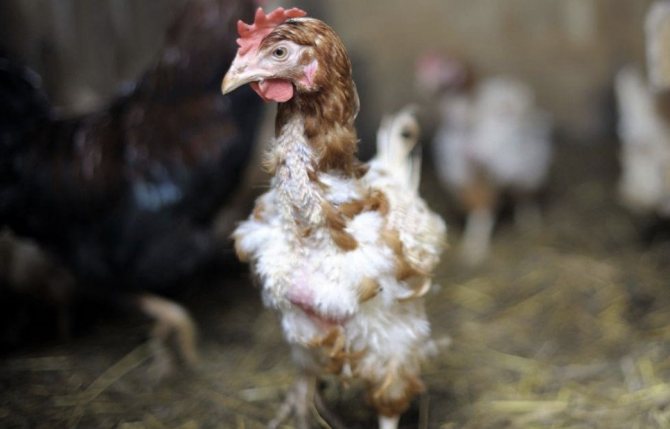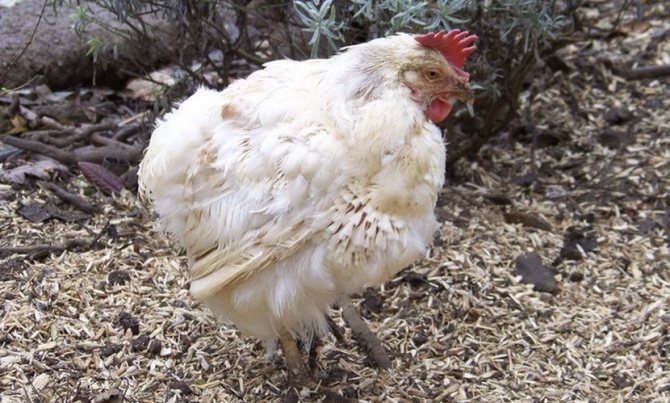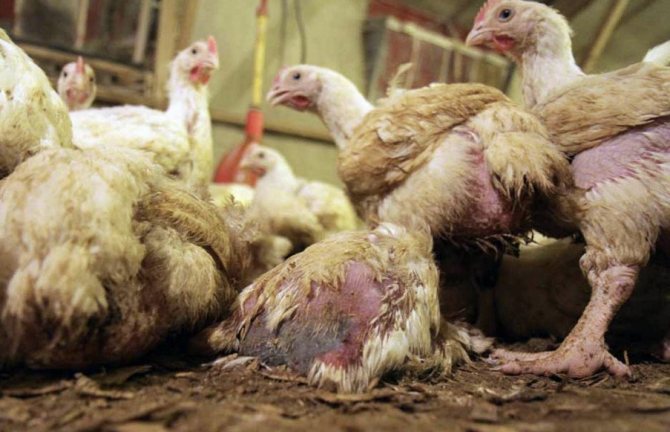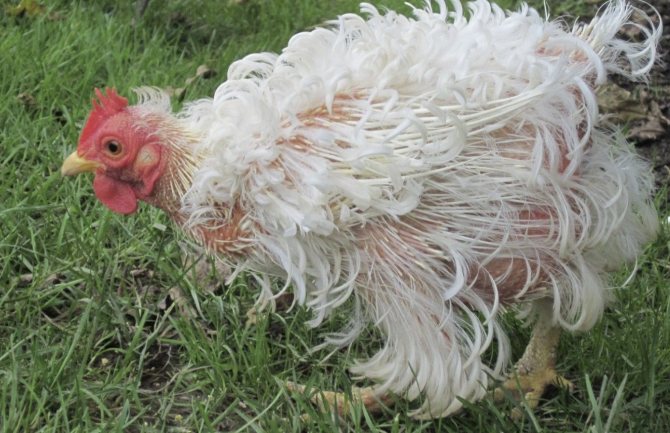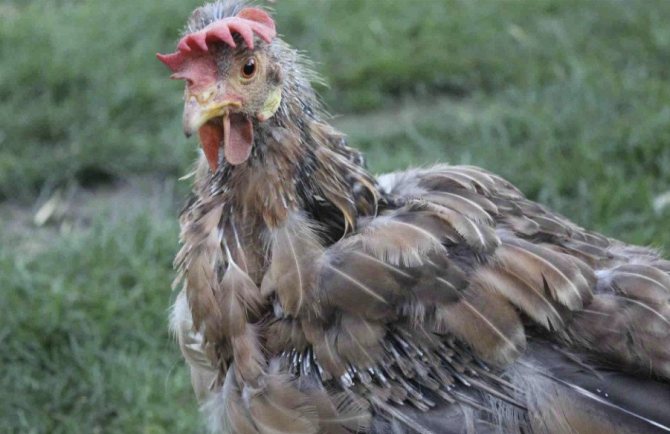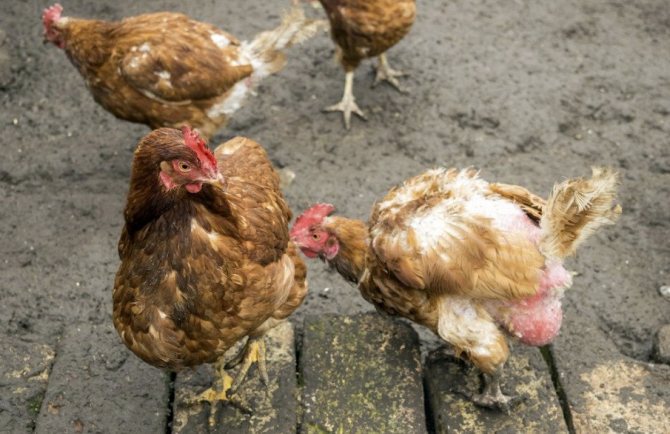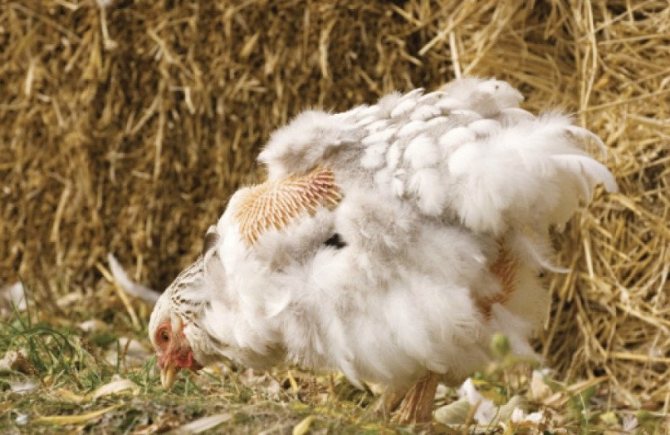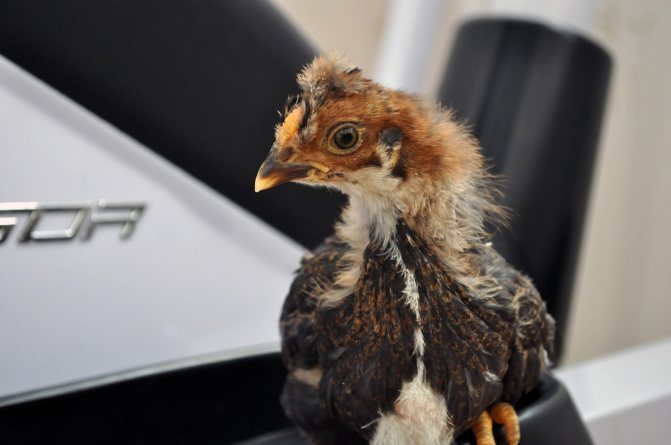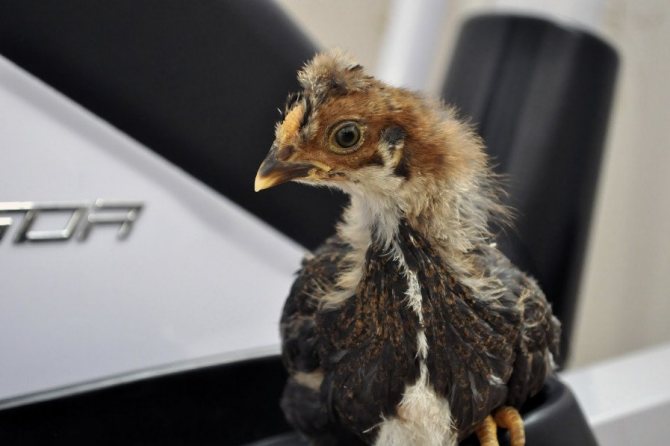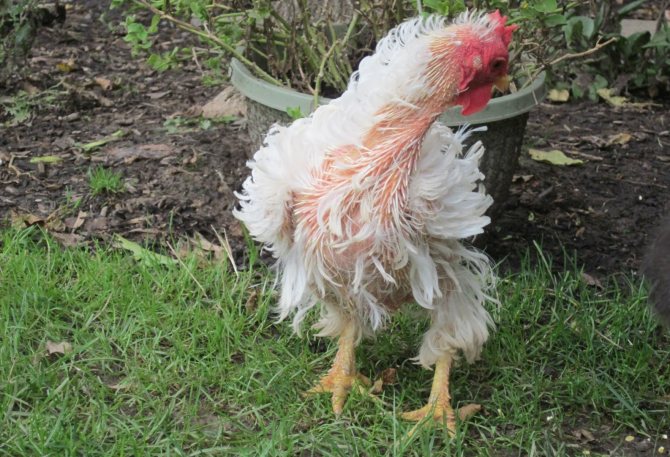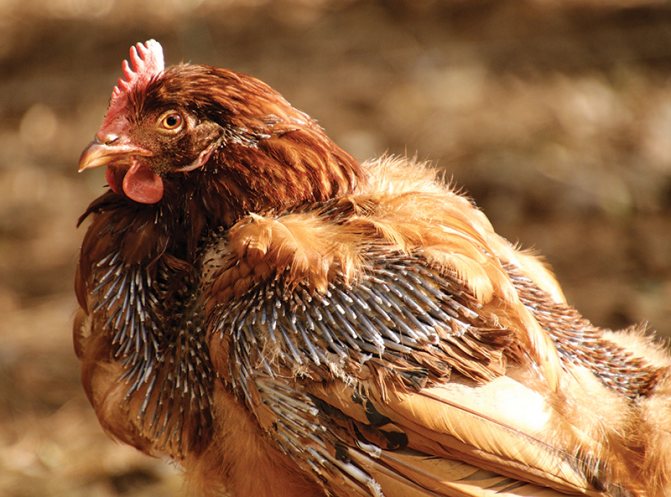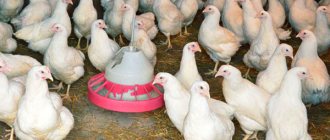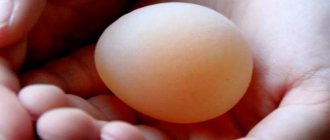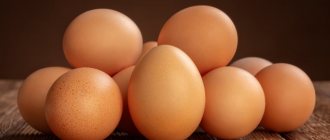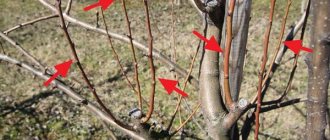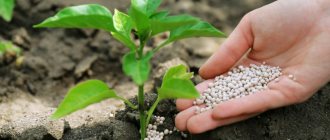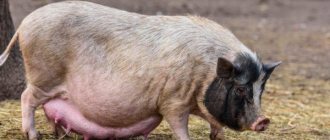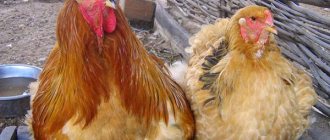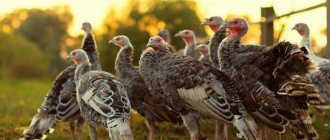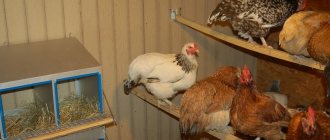Moulting in laying hens is a natural process that begins in late autumn. Birds change their plumage to a denser one, which will not allow them to freeze in winter. Chicks molt several times in the first year. During puberty, they are characterized by spring molt. In addition, there are situations when birds begin to lose feathers due to diseases, improper living conditions. In poultry farms, in order to maintain high productivity, the process is artificially triggered.
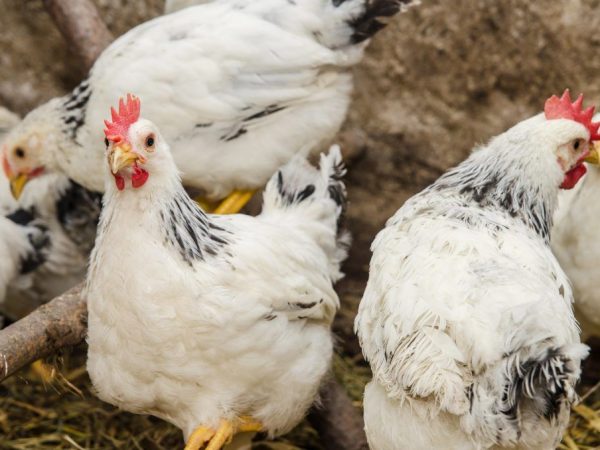
Laying hens
The main causes of shedding
Why does molt begin in domestic laying hens? The main and natural reason is the seasonal change of plumage. Also, the process is typical for chickens at different age periods. But besides this, there are other types of molt, which have their own reasons. Plumage suffers from diseases, improper feeding and maintenance, metabolic disorders. Sometimes molt is artificially induced. Pathological molting is observed in such situations:
- deficiency of vitamins and minerals;
- underfeeding, which leads to a lack of nutrients in the chicken's body;
- stressful situations;
- skin diseases, infection with parasites, helminths.
Pathological molting in chickens can begin at any time of the year, for example, in summer. The rate of feather loss varies. Sometimes the owner may not even notice the problem in the bird's appearance. Only the decrease in the number of eggs is alarming. But there are times when chickens lose almost all of their plumage, then they need immediate veterinary help.
Most often, pathological molt is caused by chewing lice or feather eaters. What these parasites look like can be seen in the photo on the Internet. In addition to the loss of feathers, reddening of the skin is noticeable in layers, a white coating at the base of the rods, they constantly itch. The loss of plumage with vitamin deficiency and metabolic disorders is accompanied by a decrease in egg production, sexual activity in males. Birds become lethargic, eat poorly, and sometimes have intestinal problems.
Possible Reasons For A Chicken Shedding Out Of Time
Molting in feathered pets can occur out of time for a number of reasons. The phenomenon is undesirable and leads to the weakening of the bird.
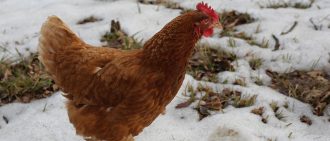

Be sure to read:
Fever in chickens - how to get rid of, an overview of symptoms and the most effective treatment
Chickens can start dropping feathers in the following cases:
- lack of vitamins and minerals in the body;
- low nutritional value of the diet;
- severe stress;
- severe helminthic lesion;
- an abundance of cutaneous parasites;
- bowel disease;
- skin pathology.
It is important to quickly eliminate the influence of the factor causing the loss of the pen. It will not be possible to stop the process completely, but it will be possible to reduce the amount of molt.
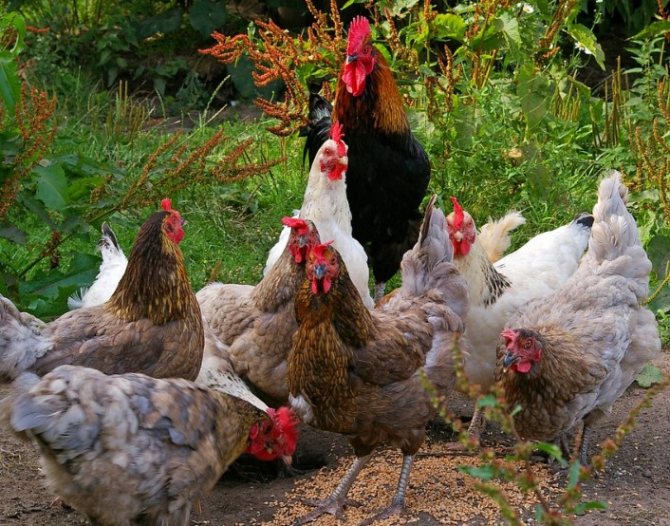

It is important to quickly eliminate the influence of the factor causing the loss of the pen.
How does natural molting go
Natural molting of chickens begins in the fall, in October or November. First, the feathers begin to fall out in the neck area, then the back sheds, after it - the tummy and wings. The tail feathers are renewed last. If you look at the photo, you can see how pathetic the faded birds look. Fortunately, the process does not last very long, after which the layers are even better than they were before the plumage change.
During the moulting period in chickens, the sensitivity of the skin increases, therefore they can react painfully to any touch. Even roosters show less activity after the start of feather change. Chickens try to hide away from people and other birds, lose their appetite, and rush badly. Any breed behaves in a similar way, even the most contact and affectionate ones.
Age or juvenile molt occurs at different periods of the chick's life. The cover is lost several times during the first months, until a real adult feather grows:
- the first one starts 7-8 days after birth and lasts about 4 weeks;
- the second begins at the age of 7 weeks, lasts up to 14 weeks;
- the third begins in spring, when the chicks turn 16 months old, after which the birds become full-fledged layers, capable of fertilization and incubation of eggs
Natural molting processes are associated with the activity of thyroid hormones. They largely depend on the length of daylight hours. When chickens molt in winter, the daylight hours are very short. If it is artificially lengthened, the plumage renewal period is significantly reduced.
It happens that in chickens at any age, natural molting begins in the summer, in July or August. The change of feathers continues for 2-2.5 months, there are almost no eggs at this time. If there are no signs of illness, such layers should be removed from the flock. Their productivity will plummet in the coming months. Neither females nor males, in which summer molt constantly occurs, are not allowed to breed.
Bird care
A molting bird must be properly looked after. Poultry farmers who have been raising chickens for many years recommend keeping the chickens in the hen house longer during the molting process. If you let them out into the street, you need to equip the paddock with additional protection from the rain.
When chickens begin to shed their plumage, it is necessary to clean the chicken coop more often. If this is not done, parasites and bacteria will begin to develop in the feathers, which in the future can infect chickens. Also, during shedding, it is impossible to physically contact the hens and change the composition of the herd.
See also
How to make an automatic chicken feeder step by stepRead
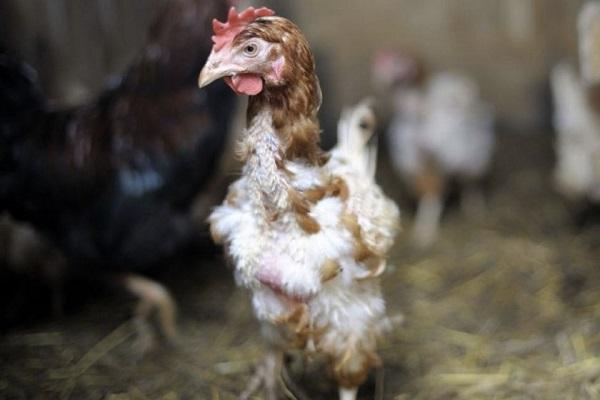

Artificial shedding
Understanding the processes that lead to molting in chickens made it possible to artificially cause it in poultry farms. At the same time, molting time is significantly reduced. All birds lose feathers at the same time, and the productivity of the flock is not particularly affected. After the temporary cessation of clutching, the chickens lay even more intensively, the total egg production of the livestock increases significantly. It is impossible to carry out artificial molting at home: too fast and forced change of feathers can not only damage the health of the bird, but also destroy the entire livestock.
There are many ways to speed up the plumage change process. The most commonly used types of artificial molt are:
Chemical method
To cause accelerated molting by chemical means, concentrated feed with a certain ratio of microelements and biologically active substances are used. They affect the synthesis of hormones in the pituitary gland, hypothalamus, thyroid and gonads. As a result, the sexual function of chickens and roosters is inhibited, the hormonal background is as close as possible to that characteristic of natural conditions during molting. The process lasts 2-3 weeks, after which egg production quickly resumes.
Hormonal technique
The hormonal method is based on the use of thyroxine, progesterone and other similar drugs. Molting begins and ends very quickly. Within a week, laying hens can produce double the number of eggs. With the wrong use of hormones, changing dosages, you can cause a persistent decrease in productivity, since the birds' own endocrine system stops working.
Zootechnical technique
The zootechnical method is the least expensive, as it does not require the use of expensive drugs. Chickens are given a water diet for 4 days: they only give to drink, but do not feed. At the same time, the duration of daylight hours is sharply reduced, birds are kept in the dark for almost the whole day. Against the background of stress and starvation, birds begin to quickly lose feathers. This forced molt does not last long. Egg production resumes within 1.5-2 weeks after stopping the diet.
What is molting
Moulting in laying hens is a process that is laid down by nature. Thanks to him, they shed their old plumage and overgrow with new ones.
Important! A healthy laying hen will only molt in the fall. This is necessary to keep the new feathers warm in winter and keep the bird from freezing.
Since old feathers give in to friction with age, fade and wear out, nature has made sure that there is an opportunity to grow new ones. The first to fall out are the feathers on the head and neck, since these are the parts that move the most. Next comes the turn of the back, since it is this part that is constantly under the influence of sunlight. Further - descend from the chest and tail.
When molt begins, birds lose weight and stop rushing. At the site of the future plumage, first tubercles appear, which are permeated with blood vessels. Soon, small tubes will appear from these tubercles, from which feathers subsequently grow. During this period, the skin becomes very sensitive, with a slight injury to the tube, blood begins to ooze from it. Therefore, laying hens, while molting, try to avoid contact, both with people and with other animals. They hide from everyone in quiet places where they will be invisible.
When chickens molt
Many owners are interested in the question: "when do hens molt?" During the first year of a chicken's life, several such periods occur:
- After the young chicks are four weeks old, the first molt occurs. At this time, the first fluff is discarded and a new one begins to grow.
- When the young are three months old, they change their plumage again. This time, contour feathers grow, such as those worn by adult birds.
- In spring, pullets molt again.
In the fall, chickens tend to change their feathers every year. Many people are interested in the questions: "How many days and when will chickens moult?" It should be remembered that in those individuals that are very productive, feathers fall out much more intensively. It is common for them to replace old ones with new ones for six or eight weeks.
Important! Those hens that look very miserable and plucked during the feather change are actually very productive and need to be protected and appreciated.
Laying hens, which run very badly throughout the year, molt from the summer, from July to August. Molting continues for several months. This goes unnoticed, as they constantly walk in dense plumage.
If the plumage of chickens changes for a long time, in addition, they become lethargic and slow, this is the first sign that you need to monitor the chicken's health and take action. The animals are sick or have suffered severe stress. A stressful situation for hens can occur:
- as a result of lack of water, because of which the bird is constantly thirsty;
- chickens are hungry and have to find food for themselves to live;
- in winter, layers receive little light.
Important! If the process of feather loss has begun in layers that are two or even three years old, and it is noticed that they are broken, then you need to immediately contact a specialist and look for ways to solve the problem, since this is unnatural for adults.
Chickens tend to change their plumage in the summer when they hatch the chicks. When they return to their normal diet, new feathers begin to actively grow. Other reasons why birds begin to shed may be the following:
- with food, the microelements necessary for development do not enter the body of the laying hen;
- lack of vitamins in the body;
- attack of parasites that bite down the plumage;
- the emergence of parasitic worms;
- diseases affecting the skin and intestines.
Once the reasons for the untimely molt are identified, they can be eliminated quickly and in a timely manner. It is necessary to immediately eliminate the stressful situation. To do this, you need to ensure that the birds constantly have enough water and food. In winter, you need to extend the daylight hours with the help of artificial lighting. Lighting for chickens is recommended for at least fifteen hours. If you eliminate all these reasons, then they will stop shedding.
Seasonal periods
Birds can shed when climatic conditions change. There are four types of molt, depending on the season:
- In the spring, chickens can shed feathers they do not need. This process begins in the month of March or April.
- In summer, feathers fall out of chickens when the body malfunctions and it ceases to function correctly. The housekeeper should be aware that summer molt is the first sign of bird disease. This period falls in July and lasts no more than a month.
- In autumn, this is the most necessary process in the chicken's body. It begins in late August or early September and lasts for fifty-five days. In winter, the chickens will already have a thick and lush plumage.
- In winter, this is the most unnatural process, since the cold season should not provoke feather loss. If this happens, then you should pay attention to the condition of the birds and their health.
Why do forced molting
In poultry farms, layers are forced to shed their old plumage in an artificial way. They begin to do this for the first time to those individuals who are at least thirty weeks old. Thus, they extend the period of their productivity. Getting a hen to shed its plumage is much more profitable than raising young.
Interesting to know! Artificial replacement of the plumage of layers contributes to an increase in the mass of eggs, the quality of chicken is significantly improved. In addition, this process significantly rejuvenates birds.
To artificially induce a change in plumage, it is necessary to create a stressful situation. To do this, they arrange a small hunger strike with the animals without drinking. Leave the living creatures in the house, which is shaded to reduce daylight hours.
How to speed up the shedding process
The molting period depends on how healthy the hen is. For a perfectly healthy laying hen, it is normal for feathers to change over ten weeks. For birds that are lagging behind in development, this process increases to fourteen weeks. With proper laying hens, shedding can be reduced to at least five weeks.
In this case, experts recommend adding special additives to feed, which contain the required amount of minerals and vitamins. And also isolate molting individuals from other birds and protect them from drafts.
Plumage change is necessary for chickens, but on condition that it occurs in the fall. Only during this period do chickens rejuvenate their bodies and prepare for winter.
Experienced poultry farmers know very well that the molting process in poultry is inevitable. And this in most cases does not mean that the livestock needs treatment. The renewal of the feather cover is provided by nature itself. Feathers that protect birds from temperature extremes at any time of the year are replaced with new ones. The process begins from the cervical region, back, abdomen. Wings and tail are the last to change plumage.
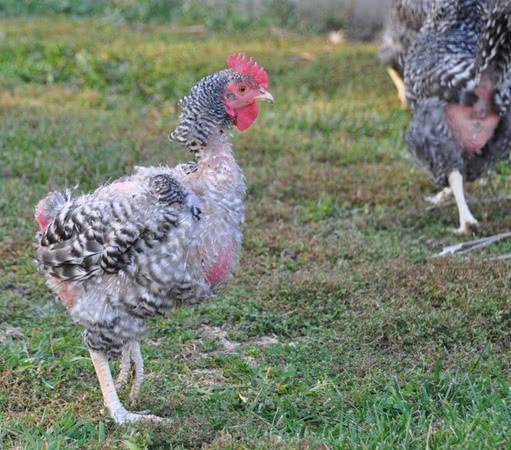

Depending on the age and conditions of detention, the change of pen takes place in different ways. Only if the bird does not recover for more than 2 months and external signs of malaise are obvious, it is worth contacting a veterinarian for advice.
In addition to natural seasonal molting, layers can lose feathers for several reasons:
- avitaminosis;
- lack of nutrients, vitamins and amino acids;
- poor feed;
- stressful situations;
- metabolic disease;
- the presence of feather parasites;
- skin diseases;
- age-related changes.
Advice! If the livestock looks healthy, there is no reason to worry and look for the causes of ailments.
During the molting period, it is necessary to promptly remove and dispose of down and feathers from chicken coops, insects - parasites can multiply on them. It is not recommended to move the bird to new premises, this can provoke stress. It is not recommended to disturb the birds unnecessarily during this period. The process for laying hens is not easy and sometimes painful.
Why chickens don't fledge after molting
There are times when the molting period has long passed, but the bald patches remain. This is an alarming sign of alopecia, a disease in which the bird becomes bald.
Did you know? In 1956, a Leghorn hen laid an unusually huge 454 g egg. It had a double shell and two yolks inside.
Possible causes of the disease:
- poor nutrition;
- unfavorable conditions of detention;
- ectoparasites: ticks, fleas, downy eaters.
To establish a diagnosis, you need to contact your veterinarian. He will prescribe the appropriate treatment.
During the molting process, the chickens look ugly, but after it they are transformed. In addition, their bodies are healed and they are ready to lay eggs again.
How long does it take for chickens to molt?
Almost always in the fall, molting is observed in an adult bird at the age of 2 years, as well as in young individuals - in the spring.
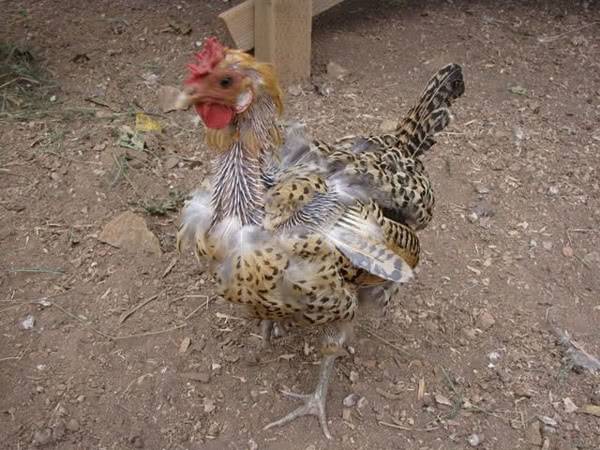

The molting period in laying hens lasts from 1 to 2 months. In a weakened bird, it can take more than 3 months and, as a rule, disappears in the summer. This refers to the natural process of plumage renewal in a healthy herd.
Important! If the process of changing plumage is delayed, the bird has become lethargic, you should consult a veterinarian.
At this time, certain changes occur in the bird's body:
- cleansing of toxins;
- metabolism accelerates;
- internal organs are stimulated;
- sexual activity stops;
- egg production decreases.
With long-term maintenance, the livestock sheds several times, the process is divided into several stages.
- Primary (juvenile). Plumage change begins at a very young age, when chicks begin to grow actively at the age of 1 month. The primary (juvenile) feather is changed to the primary. Molting time is 3-4 months. Upon reaching five months, the hen has a feather appearance that matches the breed.
- Seasonal (periodic). In the fall, before the onset of cold weather, a natural and usual molt for poultry farmers occurs. This is how the livestock prepares for lower temperatures and climate change. The timing directly depends on the age of the bird. Full-fledged layers shed their feathers and change them to new ones very quickly, starting in October. The process is slowed down in layers with a low percentage of egg production. These begin to shed in the summer. An active process is determined by the lost flight feathers on the wings. At a time, they are lost from 3 to 5 pieces. The seasonal feather change applies only to livestock kept in chicken coops with the possibility of walking outside. A bird living in cages does not stop rushing and undergoes molt gradually and almost imperceptibly.
- Age. Changes in the body with age affect productivity and are the first sign that the herd needs to be renewed. It is impractical to keep laying hens for more than 1.5 years: the meat becomes tough, the laying hen is more likely to get sick and lose weight.
- Forced. It is launched by poultry farmers using chemicals. Provides a simultaneous change of plumage and an increase in egg production later.
The bird's immune system is weakened during this period.It is not worth replenishing the herd to avoid the occurrence of infections. Having renewed the plumage, the laying hen quickly recovers and, under favorable conditions, begins to rush after 1, 5 months.
Useful video about moulting laying hens
Like the author! 25
- Even more interesting:
- How and what to feed mulard ducklings
- How to feed broiler chicks for fast growth
- We make nests for laying hens with our own hands
Discussion: 3 comments
- Tolik:
10/29/2018 at 11:03Now I know at what age the laying hens molt, thank you.
Reply
- Victoria:
12/17/2018 at 20:50
I have just started breeding chickens and such an aspect as changing feathers is new to me. I want to thank you for the tips in this article on how to help chickens change feathers. I plan to put them into practice and hope that all my chickens quickly change feathers with my help.
Reply
- Igor:
30.01.2019 at 20:15
Thank you for suggesting how to care for chickens so that there is a quick change of feathers. Now I will do everything right!
Reply
The reasons
Feathers change in different ways. Depends on the content of the bird, its age, breed and season. Sometimes the process takes place almost imperceptibly externally, sometimes the layers remain practically bald. Young healthy individuals go through this period much more painlessly and faster than adults, more than 1 year old, chickens.
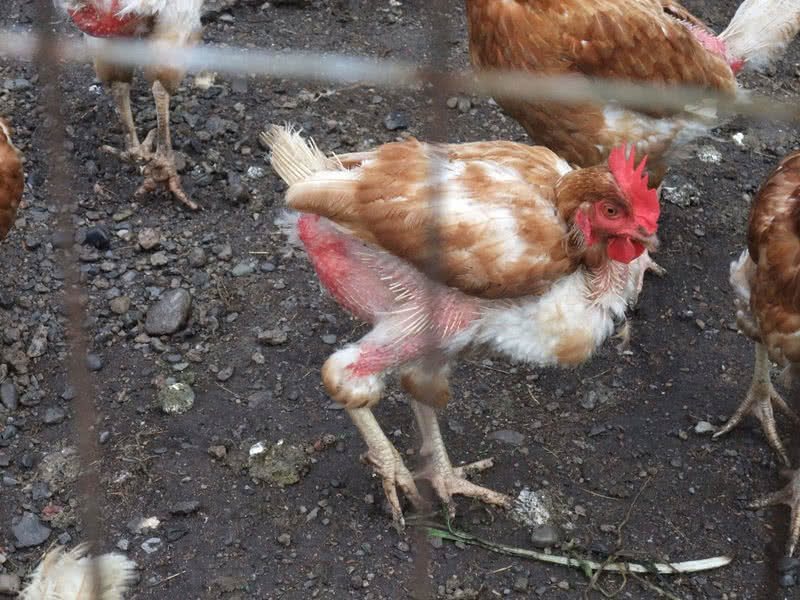

Unnatural, localized baldness can be due to several reasons. In most cases, novice poultry farmers face this problem.
Improper nutrition
In case of non-observance of the feeding rules, chickens may not receive the required amount of vitamins and microelements. In addition to the loss of feathers, they have dullness of the scallops, the absence of gloss on the plumage, and a decrease in egg production.
The diet of molting hens
Adequate feeding and regular drinking helps the birds to successfully survive the molt period and maintain their strength. At this time, the area occupied by each individual at the feeder increases to 10 cm per head. The diet of layers is varied.
During the molting period, the following components should be present in the diet:
- feed mixtures with a high protein content;
- insects, worms that replenish the body with protein and protein;
- vitamin supplements that provide a high level of vitamins A, B, C, D, K, as well as iodine and manganese;
- fresh green mass in spring, as well as vegetables, berries and fruits, in cold weather - boiled vegetables;
- bone meal, shells, fishmeal, low-fat cottage cheese will help speed up the process of growing feathers.
Feeding also includes regularly changing the water in the drinker to clean water. Sometimes it is replaced with a decoction of herbs that support the bird's body. Weakened hens are prone to disease, so the water should not be dirty.
How to speed up molting in laying hens
Artificial molting is used by poultry farmers as a method to reduce the cost of keeping poultry and increase egg production.
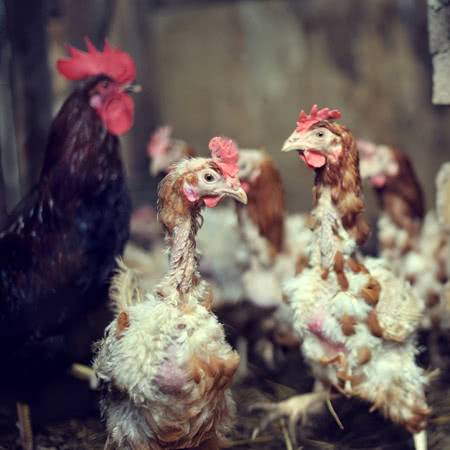

Forced shedding has a number of advantages:
- increase in egg mass up to 20%;
- improving the quality of shells, whites and yolks;
- increased chick hatching;
- getting rid of sick and weakened individuals.
Feather exchange is accelerated, usually closer to the end of the production period, at the age of 65-67 weeks, as soon as the intensity of egg-laying decreases. If the laying hens have cut production in half, you can start the forced molt procedure.
Reference! The procedure is contraindicated for poultry younger than 30 weeks.
It is recommended to separate the hens from the males in such cases. This can reduce the ability to fertilize and reduce the weight and functionality of the testes. Forced molt lasts from 1 to 1.5 months and is divided into 3 stages:
- the bird stops rushing within 4-5 days;
- feathers begin to fall out after 1.5-2 weeks;
- the feather cover is restored after 1 month, while the layers begin to lay eggs.
There are 3 main methods used: limiting daylight hours, food and water. If you combine them, it will shorten the time. On an industrial scale, in large poultry farms, hormonal and chemical preparations are used.
How to feed laying hens during molting
In addition to increased grooming, hens need an improved diet during plumage changes. The content of protein products increases:
- cottage cheese;
- yogurt;
- serum;
- boiled fish and meat;
- meat broth.
It is preferable to give vegetables boiled, mainly in the feed should be present:
- potatoes;
- carrot;
- fruits (apples, pears);
- pumpkin;
- zucchini and squash.
In order to avoid gastrointestinal disorders, it is not recommended to give beets at this time. Mineral dressing is a must. Add to feed:
Wet mash is prepared in such quantity that the bird can eat everything within half an hour. The leftovers from the table will do, but they must be fresh. It is useful to include sprouted wheat grains in the diet.
Advice! Nettle is used as a vitamin supplement. In summer, it is crushed and given fresh, as well as harvested in brooms for the winter.
In the cold season, when the hens have no opportunity to graze, berries of viburnum, mountain ash, hawthorn are mixed into the feed. Cabbage is irreplaceable as a source of sulfur. You can use all its types: kohlrabi, colored, white cabbage. The nutritious and healthy ingredients in peas and corn will help your bird to moult faster. Food is given three times a day, potassium permanganate or iodine is added to the water for prevention.
Feeding for molting birds
The body of birds during molting is greatly weakened and consumes a lot of energy. Therefore, it is recommended to formulate the correct diet to ensure a continuous supply of vitamins and other beneficial components.
Experts recommend saturating the body of chickens with manganese and iodine. These trace elements are found in beets, berries and grass. Chickens also need to be fed daily with insects and earthworms. It is contraindicated to give raw potatoes, as it impairs digestion. It is better to use boiled vegetables instead.
